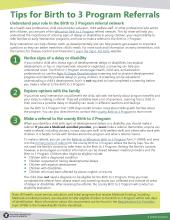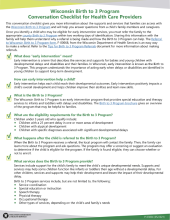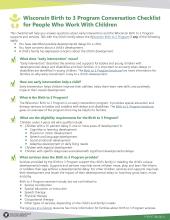Birth to 3 Program: First 1,000 Days Toolkit for Health and Child Care Professionals
This media toolkit includes messaging for health and child care professionals, or others who work with children. It can help them understand their role in the Birth to 3 Program referral network. It can also help them learn how the program works for families.
Resources
You can get free, printed copies of the materials below. Fill out a Forms/Publications Order form, F-80025A. Email it to dhsfmorder@dhs.wisconsin.gov.
Consider ordering 10 or more. Then you can share them with staff and other professionals. Please allow two to four weeks for your prints to arrive.
Referral tip sheet
The Tips for Birth to 3 Program Referrals, P-02939 (PDF), helps those who work with children understand their role in the Birth to 3 Program network. This includes:
- Health and child care professionals.
- Educators.
- Child welfare staff.
Refer to this tip sheet when you think the Birth to 3 Program might be right for a family.
- Keep a copy in your office for staff to access.
- Email to staff to remind them about their role in the Birth to 3 Program referral network.
Conversation checklists
These checklists can help you answer questions families might have about early intervention or the Birth to 3 Program.
- Use this resource to explain the program to families who you plan to refer or who might be interested in early intervention.
- Send this resource to staff who interact with families to make sure they have talking points about the Birth to 3 Program.
- Print off your own copy. Keep it in your office for staff to access.
Conversation Checklist for Health Care Providers, P-03004 (PDF)
For:
- Doctors
- Nurse practitioners
- Therapists
- Other health care professionals
Conversation Checklist for People Who Work With Children, P-03017 (PDF)
For:
- Child care providers
- Child welfare staff
- Advocates and community resources
- Other partners who work with young children
Newsletter content
Help DHS connect with:
- Health care providers.
- Child care professionals.
- Advocates.
- Others who work with children.
Share messaging that helps professionals better understand:
- Early detection of delays and disabilities.
- How and when to make a referral to the Birth to 3 Program.
- How the program serves families and children.
- Copy and paste text from articles to help develop a story in your next bulletin, newsletter, email, or website update for health and child care providers.
Copy and paste text from pre-made articles to help develop a story in your next bulletin, newsletter, email, or website update for health and child care providers.
Article about acting early and making referrals: 326 words + title
Early intervention can help children catch up to their peers developmentally and can help parents get answers to important questions so they can better meet their child’s needs. Early referrals are crucial for children, parents, and caregivers because they encourage addressing children’s needs right away, rather than waiting to act.
Wisconsin Medicaid requires early intervention referrals
If you’re a Wisconsin Medicaid-enrolled medical or service provider, you are required to refer all children who may be eligible to the Wisconsin Birth to 3 Program within two days of identification.
- Children who might be eligible include the following:
- Children with a diagnosed condition
- Children suspected of having developmental delays
- Children with atypical development
- Children with disabilities
- Children who have been affected by abuse, neglect, or trauma
The Birth to 3 Program is an early intervention special education program. The program centers on parents and caregivers as experts and supports children with all different types of delays, disabilities, or conditions. The Birth to 3 Program integrates professional and therapy services with all the people, places, and activities in the child’s world.
How to refer children to the Birth to 3 Program
To refer a child, you should do the following:
- Talk to the child’s parents or caregivers about how important early intervention is. For helpful information on how to talk to families about the Birth to 3 Program, you can visit the Birth to 3 Program First 1,000 Days toolkit.
- Reach out to the Birth to 3 Program in the county where the child lives to refer the child to the program. The Tips for Birth to 3 Program Referrals, P-02939 (PDF), has helpful information about how referrals work.
You can find more information about the requirement to refer children to the Birth to 3 Program within two days in the Requirements for Providers topic (#788) in the ForwardHealth Online Handbook. The Birth to 3 Program will share more information about supports and services with families and caregivers.
Article to help health care providers use well-child visits to screen for delays or disabilities and act early: 577 words + title
It’s essential to act early when signs of delays or disabilities are present in a child, especially in the first few years of life. When you ask parents or caregivers about a child’s development during a well-child visit, make sure to note any signs of delays or disabilities and talk to the family about early intervention options right away.
The sooner a family engages with early intervention supports and services, the more time they have to work with a team of professional service providers to support positive outcomes for the child. Early intervention provides educational and therapy services for the child and helps address parent and caregiver questions and provides resources for them. For more tools and information on early intervention, visit the Centers for Disease Control and Prevention’s Learn the Signs. Act Early. website. They also have more information on early intervention.
Know the signs
The Ages & Stages Questionnaires (ASQ) screening tool can help health care, child care, and special education professionals understand more about a child’s development. The ASQ screening tool helps pinpoint developmental progress and identify possible delays in young children. The Birth to 3 Program encourages providers to use the ASQ with all children. A resource that explains the ASQ screening tool in more detail is available on the Ages & Stages website. For more information about evidence-supported practices, refer to the clinical report, Early Intervention, IDEA Part C Services, and the Medical Home: Collaboration for Best Practice and Best Outcomes.
If you are a Medicaid-enrolled provider and you think a child has a delay or disability, you must refer them to the Birth to Program. You do not need a family’s consent to make a referral to the Wisconsin Birth to 3 Program.
When you make a referral, it is helpful to share the results of the ASQ screening. You must get the family’s consent to share the results of the screen. Sharing the ASQ results with the local Birth to 3 Program helps the program talk with the family about the areas of concern for the child.
Explore the options
Help parents or caregivers make informed choices by talking with them about steps to support the child’s development and address a possible delay or disability. Therapy, medical treatment, and early intervention programs are best discussed through the lens of the family’s culture, beliefs, and individual needs.
Help children grow and learn with the Wisconsin Birth to 3 Program
The Birth to 3 Program is an early intervention special education program. The program centers parents and caregivers as experts and supports children with different types of delays, disabilities, or conditions. The Birth to 3 Program integrates professional and therapy services with all the people, places, and activities in the child’s world.
A child does not have to be diagnosed with a delay or disability to be eligible for the Birth to 3 Program. Children who might be eligible include:
- Children with developmental delays
- Children with atypical development
- Children with disabilities
- Children who have been affected by abuse, neglect, or trauma
For more information about eligibility, the Birth to 3 Program approach, how to talk to families about the program, and how to refer, visit the Birth to 3 Program First 1,000 Days toolkit. To learn more about the Birth to 3 Program, visit the Wisconsin Birth to 3 Program website.
For more information about other children’s services programs available through the Wisconsin Department of Health Services, visit the Children’s Services webpage.
Article to explain the Birth to 3 Program: 747 words + title
Share information about the Wisconsin Birth to 3 Program when you talk with families about supports for the child’s development. The Birth to 3 Program is an early intervention special education program. The program centers parents and caregivers as experts and supports children with different types of delays, disabilities, or conditions. The program integrates professional and therapy services with all the people, places, and activities in the child’s world.
The Birth to 3 Program partners with parents and caregivers. The program uses the expertise of a team of professional service providers to expand parent and caregiver knowledge and support the child’s development.
Every family that enrolls in the Birth to 3 Program has access to professional therapists, special education teachers, and service providers to support the child’s growth and development. One of these professional service providers is the primary coach who coordinates information and services from the team. Having a primary coach lets the family and child develop a relationship with one main person.
The team, primary coach, and family spend time identifying the routines of the family and the activities the child finds interesting. The program takes the family’s culture, beliefs, and individual needs and outcomes into account when determining how to provide services. The activities identified by the family are incorporated into the individualized family service plan (IFSP).
Who is involved in developing the individualized family service plan?
The Birth to 3 Program develops the family’s IFSP with an IFSP team. The IFSP team includes, but is not limited to, the following:
- The parents or caregivers of the child
- Other family members, as requested
- An advocate or person outside the family if the parent requests that person’s participation
- The service coordinator designated by the public agency to implement the IFSP
- Professionals directly involved in conducting the evaluations and assessments in the Individuals with Disabilities Education Act § 303.321
- Professionals who will be providing early intervention services under the Individuals with Disabilities Education Act § 303.321 to the child or family, as appropriate
What services does the Birth to 3 Program offer?
Birth to 3 Program services can include special education and instruction services, physical, occupational, and speech therapy, hearing and vision services, or assistive technology. All services are based on the individual goals and outcomes of the child and family.
Birth to 3 Program supports are provided by a full team of professional service providers. The program team consists of the following:
- Service coordinator
- Early childhood special education teacher
- Speech therapist
- Occupational therapist
- Physical therapist
- Other professionals or service providers needed to meet the child’s developmental needs
When and how often are services provided?
Services are unique to each child and family. Birth to 3 Program services are provided when they work best for the needs of the family and child. The team can revisit the time, duration, and frequency of the services at any time.
Where are services provided?
Children learn and grow in the place where they spend the most time. The Birth to 3 Program provides services in the child’s natural environments so the child will develop and learn in the same settings that they will use their new skills. The child’s natural environments include places like their home, childcare, and other places where they spend time in their daily life.
For example, an occupational therapist might help parents or caregivers position the child in their car seat so they can enjoy a car ride and visit their grandparent. The occupational therapist might show the parent or caregiver how to use songs to engage the child in the car and give them tips to practice throughout the week that make going to the grocery store easier for the family and child.
How are decisions made?
All decisions about what services are right for the child and how they are provided are made by the IFSP team, which includes the family. The family’s routine, values, culture, priorities, and goals are all used to guide these decisions.
Together, the team creates the IFSP, which notes all identified goals and outcomes that are important to the family. The IFSP also details what strategies, resources, supports, and services are needed to reach the family’s goals and outcomes.
The IFSP can be changed at any time, especially as the child learns, grows, and develops. When parents and caregivers decide something isn’t working, want to change something, or have questions about the services being provided, they can talk with their service coordinator or primary coach at any time.
Article to remind providers that children exposed to abuse or neglect may be eligible for the Birth to 3 Program: 180 words + title
Delays and disabilities sometimes occur as a child develops. However, trauma—stress, abuse, neglect, or other negative experiences—can also significantly and negatively impact a child’s development, especially for very young children.
Health care professionals, child care providers, physical therapists, occupational therapists, speech and language pathologists, special educators, and others who interact with young children should be aware of the detrimental impact of trauma on child development. Children who experience these situations may be eligible for early intervention programs, including the Wisconsin Birth to 3 Program. The Birth to 3 Program integrates professional and therapy services with all the people, places, and activities in the child’s world. The Birth to 3 Program is an early intervention special education program that centers parents and caregivers as experts since they know the child best.
Remember, if you are a Wisconsin Medicaid-enrolled provider, you must refer all children under the age of 3 who are suspected to have delays or disabilities to the Birth to 3 Program. To learn more about the Birth to 3 Program, visit the Birth to 3 Program website.



